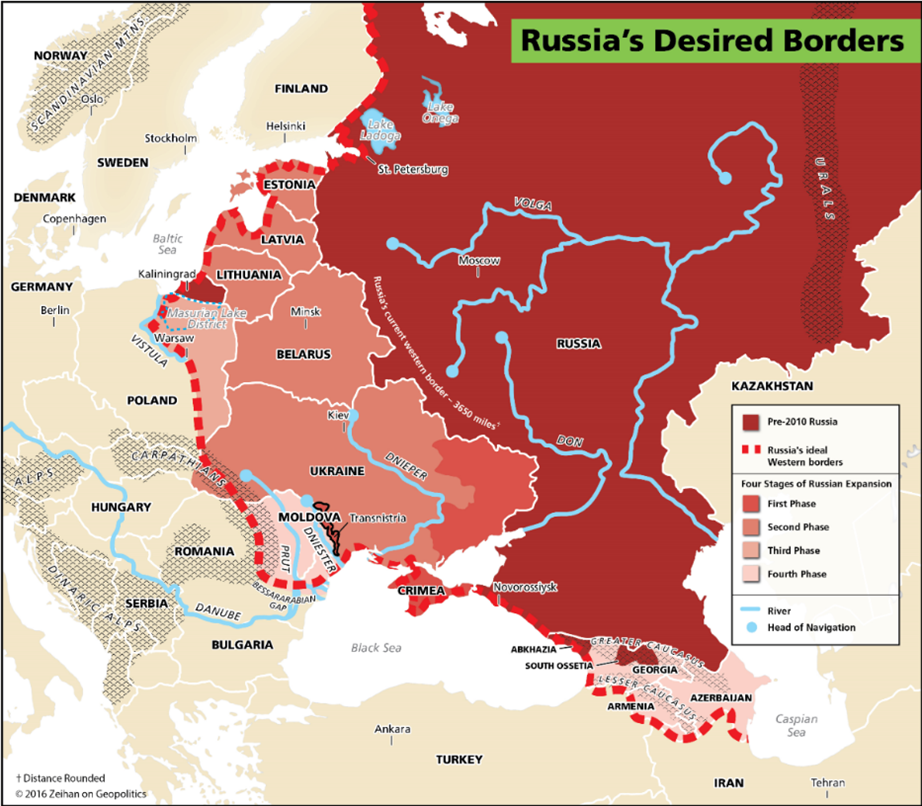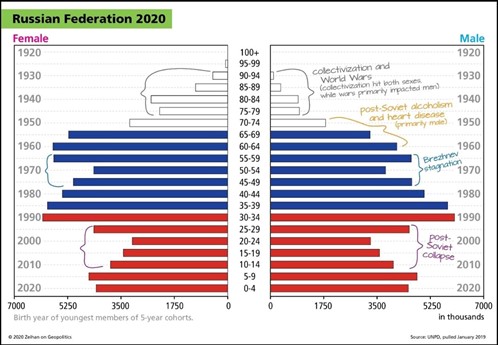UKRAINE AND THE END OF RUSSIA
 Russia’s impending doom is a driving force to invading Ukraine.
Russia’s impending doom is a driving force to invading Ukraine.
For centuries, Russia’s rulers have thought Russia’s border regions are indefensible. There are few geographic barriers to block potential invasion, forcing the Russians with their dwindling numbers to attempt to defend massive stretches of territory.
What barriers the Russians do have now — Crimea and the Caucasus come to mind — are only because of the sort of strategic adventurism that Putin is now threatening to Ukraine as a whole.
There is a method to the madness. To paraphrase Catherine the Great, Russia can expand, or Russia can die. Today, that means Russia is going to die.
One catalyst has been the big change in Ukrainian politics and identity.
Back in the 2000s, Ukraine could be very charitably called “messy.” It was an oligarch playground, sharply divided into three competing regions.
The biggest region in the east was populated by either Ukrainians who spoke Russian as their first language, or actual Russians who due to the quirks of history happened to live on the Ukrainian side of the dotted line on the map. Ukraine has always been home to the greatest concentration and number of ethnic Russians outside of Russia’s borders. And these groups — both the ethnic Russians and the Russian-speaking Ukrainians — were unapologetically pro-Moscow.
It was the mix of this pro-Russian sentiment with the Kremlin’s view that large-scale political violence is often useful, that set us onto the path to where we are today. In early 2014 then-Ukrainian president Victor Yanukovych — one of those pro-Russian Ukrainians — dealt with pro-Western “Euromaidan” protesters by using Ukrainian special forces to shoot up a couple thousand people. He was driven out of office and ultimately out of country and now he is living in exile in, you guessed it, Russia.
Yanukovych’s actions against his own people — actions publicly supported by none other than Vladimir Putin — started Ukraine down the road to something once dismissed out of hand: political consolidation and the formation of a strong Ukrainian identity. Putin didn’t — hasn’t — figured that out. Later Russian actions — starving the Ukrainians of fuel, annexing Crimea, invading the southeastern Ukrainian provinces of Donetsk and Luhansk in the Donbas War — only deepened the Ukrainian political consolidation that Yanukovych inadvertently started.
Far from capitalizing on strong and legitimate pro-Russian sentiment, Russia’s policies towards Ukraine these past seven years have turned even the most pro-Moscow Russian citizens of Ukraine into Ukrainian nationalists. Before the February 24 invasion.
In 2010, Ukraine was not a country. It was simply a buffer territory between Russia and the European Union with no real identity, and it would have been ridiculous to admit such a non-entity into either the EU or NATO. Today Ukraine is a country, and the idea of EU or NATO membership is fast becoming reality. And that evolution is all because of Putin’s ongoing miscalculations.
Then there’s military reality.
Back in 2014 when the Russians launched the Donbas War, Putin boasted that should he choose, Russian forces could easily invade Ukraine. He noted Russian troops could be in Kiev in under a month.
It may have been a brag, but it most definitely was neither a bluff nor an exaggeration. The Russian military may be a pale shadow of its Soviet forebearer, but Ukraine’s military in comparison? Phbbbbt. Wracked by corruption, enervated by a lack of motivation, armed with nothing more than the pre-1992 equipment that the Russians chose to leave behind when the Soviet Union fell?
There’s a reason Yanukovych used the special forces to suppress the Euromaidan protestors. The military wasn’t even up to that job. Fighting a hundred thousand or so Russian troops? That’s funny.
Since 2014, things have gotten seriously better. Western assistance has professionalized the forces. The Russian invasion has charged Ukrainian commanders some high tuition at the school of Real-Life War. Strengthening national identity has improved force cohesion. But the biggest shift is in weaponry.
The Americans started with providing the Ukrainians with Javelin anti-tank missiles. Javelins are man-portable and shoulder-launched, weighing in at under 50 pounds. They shoot high and plunge down, striking tanks on the top where armor is weakest. And above all, they are sooooo eeeasy to operate. If you can make it to level 3 on Candy Crush, you can use a Javelin.
Considering any drive to Kiev will be a tank operation, giving Javelins to the Ukrainians is like giving water to firefighters. It’s the perfect tool for the job. The Javelins made their wartime debut on the front lines in Donbas only in November 2021…about when the Kremlin started getting all screechy and demanding wholesale changes to European security alignments. Coincidence? I think not.
Unlike in the 2000s or in the Donbas War, at the end of 2021 the Ukrainians could now slip a knife through the chinks in the Russians’ armor and make them bleed. A lot. And unlike in the 2000s, the Ukrainians now have a national identity to rally around and fight for. The Ukrainians now have the means and motive.
Which brings us to the final bit of this story: demographics.
Russia’s had a rough time of…everything. The purges of Lenin and Stalin. The World Wars. The post-Soviet collapse. Horrific mismanagement under Khrushchev and Brezhnev and Yeltsin. Sometimes in endless waves, sometimes in searing moments, the Russian birthrate has taken hit after hit after hit to the point that the Russian ethnicity itself is no longer in danger of dying out, it is dying out.
And for this particular moment in time, there just aren’t many teens today to fill out the ranks of the Russian military tomorrow. The implications of that fact are legion.
Least importantly, if somewhat amusingly, is the Russians are now flat-out falsifying their demographic data so the situation does not look so…doomed.
Check out the bottom two age categories in the above graphic; the section for children 10 and under. A few years ago the Russians started inflating this data. Best guess is there are probably one-quarter to one-third fewer children in Russian than this data suggests. That’s roughly a four million child exaggeration.
Most importantly are the implications for the Russian-Ukrainian War. Any Russian solider lost anywhere cannot be replaced. And over 20,000 Russian soldiers have already been killed
The war and occupation will not just be expensive and bloody, it will expend what’s left of the Russian youth.
There was a demographic and strategic moment a few years ago when the Russians could have conquered Ukraine easily. That moment is gone and will not return. But the strategic argument that a Russia that cannot consolidate its borders is one that dies faster remains.
Perhaps the biggest change in recent years is this: the Russian assault on Ukraine may well be Russia’s last war.
A Russian-Ukrainian war would keep the bulk of the Russian army bottled up in a Ukrainian death-trap that would be equal parts desperate and narcissistic until such time that Russia’s terminal demography transforms that army into a powerless husk.
It is difficult to imagine a better, more thorough, and above all safer way for Russia to commit suicide.
Peter Zeihan is a professional geopolitical strategist. His next book, The End of the World Is Just the Beginning: Mapping the Collapse of Globalization, will be published in June.


